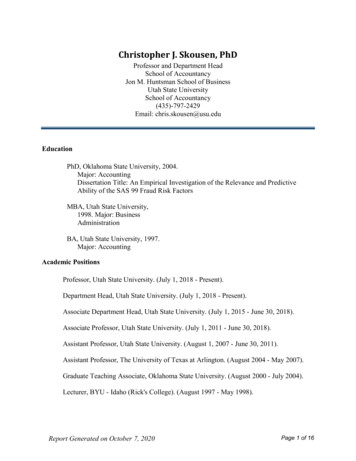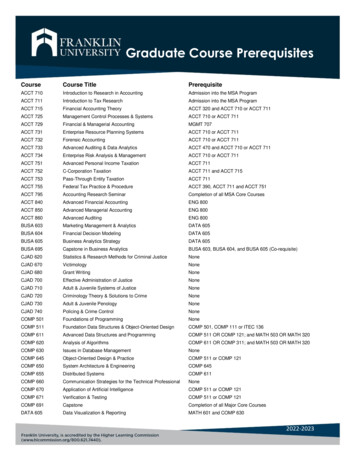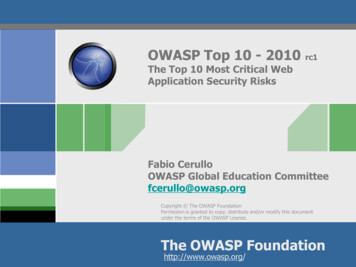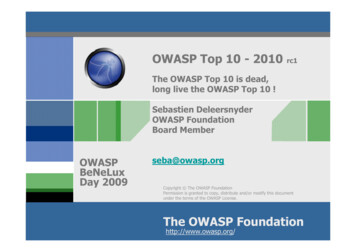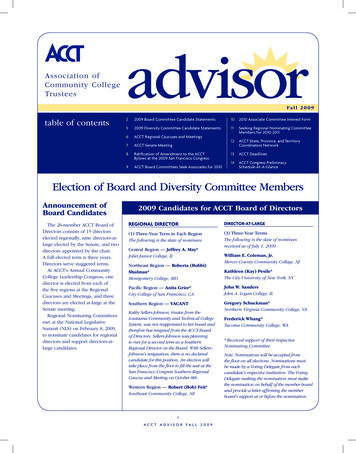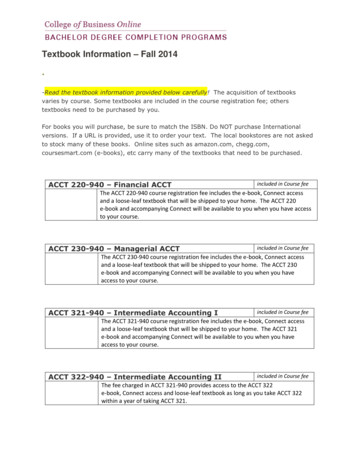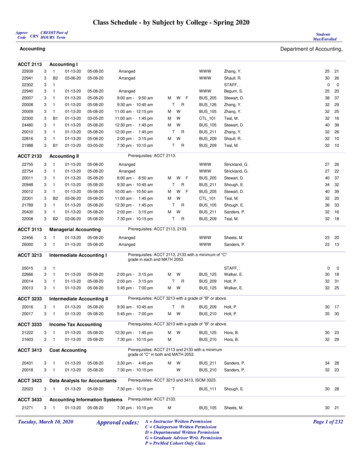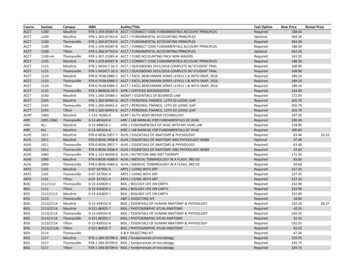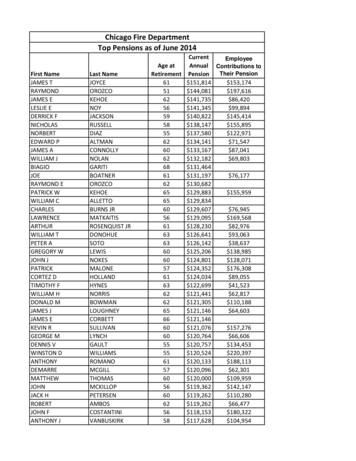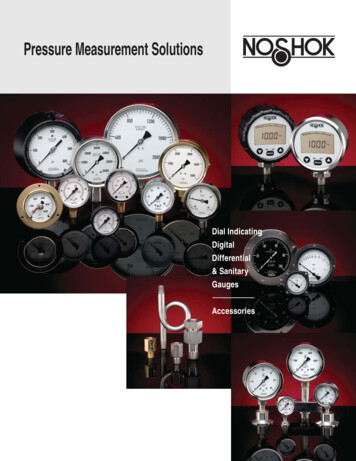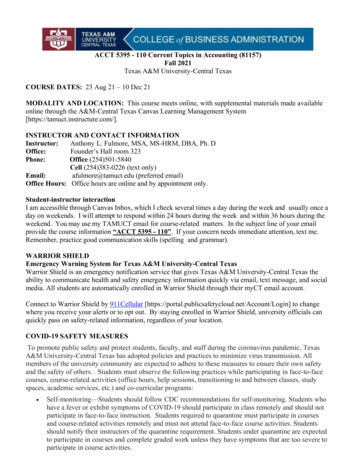
Transcription
ACCT 5395 - 110 Current Topics in Accounting (81157)Fall 2021Texas A&M University-Central TexasCOURSE DATES: 23 Aug 21 – 10 Dec 21MODALITY AND LOCATION: This course meets online, with supplemental materials made availableonline through the A&M-Central Texas Canvas Learning Management System[https://tamuct.instructure.com/].INSTRUCTOR AND CONTACT INFORMATIONInstructor:Anthony L. Fulmore, MSA, MS-HRM, DBA, Ph. DOffice:Founder’s Hall room 323Phone:Office (254)501-5840Cell (254)383-0226 (text only)Email:afulmore@tamuct.edu (preferred email)Office Hours: Office hours are online and by appointment only.Student-instructor interactionI am accessible through Canvas Inbox, which I check several times a day during the week and usually once aday on weekends. I will attempt to respond within 24 hours during the week and within 36 hours during theweekend. You may use my TAMUCT email for course-related matters. In the subject line of your emailprovide the course information “ACCT 5395 - 110”. If your concern needs immediate attention, text me.Remember, practice good communication skills (spelling and grammar).WARRIOR SHIELDEmergency Warning System for Texas A&M University-Central TexasWarrior Shield is an emergency notification service that gives Texas A&M University-Central Texas theability to communicate health and safety emergency information quickly via email, text message, and socialmedia. All students are automatically enrolled in Warrior Shield through their myCT email account.Connect to Warrior Shield by 911Cellular n] to changewhere you receive your alerts or to opt out. By staying enrolled in Warrior Shield, university officials canquickly pass on safety-related information, regardless of your location.COVID-19 SAFETY MEASURESTo promote public safety and protect students, faculty, and staff during the coronavirus pandemic, TexasA&M University-Central Texas has adopted policies and practices to minimize virus transmission. Allmembers of the university community are expected to adhere to these measures to ensure their own safetyand the safety of others. Students must observe the following practices while participating in face-to-facecourses, course-related activities (office hours, help sessions, transitioning to and between classes, studyspaces, academic services, etc.) and co-curricular programs: Self-monitoring—Students should follow CDC recommendations for self-monitoring. Students whohave a fever or exhibit symptoms of COVID-19 should participate in class remotely and should notparticipate in face-to-face instruction. Students required to quarantine must participate in coursesand course-related activities remotely and must not attend face-to-face course activities. Studentsshould notify their instructors of the quarantine requirement. Students under quarantine are expectedto participate in courses and complete graded work unless they have symptoms that are too severe toparticipate in course activities.
Face Coverings— Face coverings must be worn inside of buildings and within 50 feet of buildingentrances on the A&M-Central Texas Campus. This includes lobbies, restrooms, hallways, elevators,classrooms, laboratories, conference rooms, break rooms, non-private office spaces, and other sharedspaces. Face coverings are also required in outdoor spaces where physical distancing is notmaintained. The university will evaluate exceptions to this requirement on a case by case basis.Students can request an exception through the Office of Access and Inclusion in Student Affairs.o If a student refuses to wear a face covering, the instructor should ask the student to leave andjoin the class remotely. If the student does not leave the class, the faculty member shouldreport that student to the Office of Student Conduct. Additionally, the faculty member maychoose to teach that day’s class remotely for all students. Physical Distancing—Physical distancing must be maintained between students, instructors, andothers in the course and course-related activities. Classroom Ingress/Egress—Students must follow marked pathways for entering and exitingclassrooms and other teaching spaces. Leave classrooms promptly after course activities haveconcluded. Do not congregate in hallways and maintain 6-foot physical distancing when waiting toenter classrooms and other instructional spaces.The university will notify students in the event that the COVID-19 situation necessitates changes tothe course schedule or modality. COURSE INFORMATIONCourse Overview and DescriptionExplore selected topics of current interest in financial accounting.Course ObjectiveIn this course, you will apply and synthesize accounting concepts related to financial accounting,applications, and financial statements presentations. You will apply accounting research tools to currentand emerging accounting issues, integrate accounting theory and practice through research, anddemonstrate the ability to make sound financial decisions. The successful student, upon completion ofthis course, will be expected to have achieved the following in this course:1.2.3.4.Integrate prior accounting knowledge in making sound financial decisions.Analyze case studies using financial and business data to produce reports.Evaluate current and emerging ethical and regulatory issues.Apply problem-solving skills to diverse accounting including situations international settings.Recommended Reading and Textbook(s)1. Publication Manual of the American Psychological Association, 6th Edition AmericanPsychological Association Softcover, ISBN-13 978-14338056152. Skills for Accounting Research FASB Codification & elFRS Text & Cases, ISBN 9781618533159
3. A Plain English Handbook: How to Create Clear SEC Disclosure Documents, available online atwww.sec.gov/pdf/handbook.pdfCOURSE REQUIREMENTSThere will be a variety of graded and non-graded activities throughout the semester. Each activity will assessyour command of the material as well as your understanding of the course goals and concepts. Activities areassigned and completed during the class period unless otherwise noted and cannot be turned in late or ifclasses are missed.Case Studies: Several written case studies will be completed during the course.Research Project: The purpose of the project is to reinforce skills that are essential for professionalsuccess. Specifically, the project will require students to research their selected topics, summarize theinformation they collect, and communicate their findings in an effective manner. There are two types ofprojects that would be acceptable for this assignment:1. Discussion of an Emerging Issue in the Profession –Students will be required to identify anemerging issue pertaining to the accounting profession. For example, what is the issue, and why isit important? What events led to the change in standards/laws/regulations? What groups areresponsible for developing/implementing the proposed change? What are the expectedbenefits/costs of the proposed change, and who is expected to be impacted?I am willing to consider a broad range of topics. However, all topic proposals must be approved in advance.Each student will be required to provide a one-page proposal describing the topic they have selected. Topicswill be approved on a first-come, first-served basis - duplicate topics will not be permitted. At the end ofthe semester, each group will provide a 3,000-word paper and a 15-minute in-class presentation. Thewritten report should include in-text citations where needed and a complete reference list.
Grading Criteria Rubric and ConversionStudents earn their course grades by completing scheduled assignments; no extra credit assignments aregiven. To satisfactorily pass this course, students must complete each of the graded items listed below.Failure to submit appropriate documents for scoring in each category will result in a failing grade.Course ElementCase StudiesResearch PaperDiscussionPercent of Course GradeTotalGrade Equivalents:If Grade is ComputedNumerically90.0 - 100 % A80.0 - 89.9% B70.0 – 79.9% C60.0 – 69.9% D0 – 59.9% F60%30%10%100%If Grade is Computed by LetterA B C D F 95%85%75%65%0%Posting of GradesGrades will be posted on the Canvas Grade book (turn-around time for grades to be posted is seven days).
COURSE OUTLINE AND CALENDARWeekDateReadings124-AugResearch Paper – Topic Due (Justification, 350 words)231-AugCase: A Codification Exercise on the Reporting of Discontinued Operations37-Sep414-Sep521-SepResearch Paper – Outline Due (700 words)Case: Toshiba’s Creative Accounting for Construction Contracts628-Sep75-Oct812-OctResearch Paper – Rough Draft Due (1500 words) - Submit to AAACase: Fraud Risk Brainstorming at Tesla (Part 1)919-Oct1026-Oct112-NovResearch Paper – Rough Draft Due (2000 words)Case: Fraud Risk Brainstorming at Tesla (Part 2)129-Nov1316-NovCase: Don’t Leave Your Hand in the Cookie Jar1423-Nov
1530-Nov167-DecCase: Ace Fertilizer Company: Ethical Cost Allocations and PriceDeterminationResearch Paper – Final Draft Due (3000 words) with PowerPoint- Present findings the last week of school.Weeks 1, 2, & 3 (24 Aug – 13 Sept)Research Paper – Topic Due (Justification, 350 words)Readings PWC website. (n.d.). Retrieved ounting- reporting.htmlPurdue University. (n.d.). Format for written case analysis. Retrievedfrom http://users.ipfw.edu/todorovz/caseformat.docA Codification Exercise on the Reporting of Discontinued OperationsRead the following case study:McNellis, C. J. (2018). Dynamic divestures: A codification exercise on the reporting ofdiscontinued operations. Issues in Accounting Education, 33(1), 53–63.Case Requirements:During the first week of 20X8, Dynamic’s corporate controller, Anne Smith, prepares toinitiate the closing activities for 20X7. The closing process at Dynamic is very extensive,as it includes routine activities for consolidating the activities ofseveral subsidiary companies for the creation of the consolidated financial statements.Furthermore, Dynamic’s reporting personnel must also address the unique complications ofeach acquisition and divesture.As Ms. Smith awaits the final financial statement numbers prepared by the reporting personnelat each subsidiary, she is anxious to determine the appropriate financial statement presentation ofthe three subsidiaries discussed above. Most specifically, she is curious as to whether thefinancial performance of each of the three subsidiaries qualifies for reporting under discontinuedoperations. Ms. Smith has asked you to review the intricacies of ZD Consulting, HopeIndustries, and AM Mining Operations to determine which type of reporting (i.e., continuingoperations versus discontinued operations) is appropriate for each subsidiary on Dynamic’sconsolidated income statement.To complete the case requirements, you should perform the following tasks: Consider the facts presented for each company within the case.Consult the FASB Accounting Standards Codification for guidance on the specific income
statement presentation issue to which the controller has requested answers.Prepare a memo that clearly addresses the issue, discusses each company’s facts, and provides aclear conclusion regarding the appropriate presentation of each company’s financial information onDynamic’s consolidated income statement.In constructing this memo, you should expect to incorporate Accounting StandardsCodification references as required to support your conclusions.Include any basic calculations used in your analysis from the data provided as part of yoursubmission.Assignment Paper Requirements: Write a paper (memo) of a minimum of six double-spaced pages, not counting thetitle and reference pages (which you must include).Copy and paste each one of the questions into your paper in bold type to ensure youhave answered each of the assignment requirements.Use terms, evidence, and concepts from class readings, including professionalbusiness language.Cite at least three credible, academic, or professional sources for this assignment.The TAMUCT Library is a great place to find resources, as well as the FASBCodification.Format your paper according to APA Requirements.
Week 4, 5, & 6 (14 Sept – 4 Oct)Research Paper – Rough Draft Update Due (1500 words)Toshiba’s Creative Accounting for Construction ContractsRead the following case study:Dugar, A., & Gujarathi, M. R. (2018). Toshiba’s creative accounting for constructioncontracts. Issues in Accounting Education, 33(3), 117–134.Case Requirements:The FASB and the IASB have issued a joint standard on revenue recognition. Although thestandard is not applicable to years discussed in the case, the substantive guidance foraccounting on long-term contracts was not changed. Therefore, address all the requirementsbelow, including FASB codification references, in accordance with the new U.S. standard(Toshiba follows U.S. GAAP). Read the requirements carefully and answer each part of thefollowing requirements.Requirement 1:Are Toshiba’s accounting policies for long-term construction contracts—as described in theaccounting policies section of the case—consistent with the U.S. GAAP? Cite authoritativepronouncements from the Accounting Standards Codification (ASC) in support of your answer.Your response should focus on Toshiba’s choice of accounting policies rather than itsimplementation of those policies.Requirement 2:For Project G, the 114 million and 107 million discrepancies were treated as ‘‘uncorrectedmisstatements’’ and hence were not disclosed. Under U.S. GAAP, is non-disclosure ofunresolved differences in opinion between a company’s management and its auditorspermissible? On what criterion should the decision to disclose (or not disclose) the unresolveddifferences be based? Explain.Assignment Paper Requirements: Write a paper (memo) of a minimum of six double-spaced pages, not counting thetitle and reference pages (which you must include).Copy and paste each one of the questions into your paper in bold type to ensure youhave answered each of the assignment requirements.Use terms, evidence, and concepts from class readings, including professionalbusiness language.Cite at least three credible, academic, or professional sources for this assignment.The TAMUCT Library is a great place to find resources, as well as the FASBCodification.Format your paper according to APA Requirements.
Weeks 7, 8, & 9 (5 Oct – 25 Oct)Research Paper – Rough Draft Update DueReadings Hofmann, S. (2019, January/February). 5 most scandalous frauds of 2018.Retrieved from https://www.fraud-magazine.com/2018Top5Frauds/ Vona, L. (2019, March/April). Using data analytics to find fraud under those shells. FraudMagazineFraud Risk Brainstorming at Tesla (Part 1)Read the following case study:Hess, M. F., & Andiola, L. M. (2018). Fraud risk brainstorming at Tesla Motors. Issues inAccounting Education, 33(2), 19–34.Case Requirements:In a paper, address the following questions. Fraud risks related to Tesla’s culture, leadership, and governance structure.o How would you describe the ‘‘tone at the top’’ set by Tesla’s leader, Elon Musk?How do Mr. Musk’s leadership style and his ‘‘tone at the top’’ contribute topossible fraud risk at Tesla Motors?o How would you describe the company’s culture? How might this culturecreate pressures and rationalizations for fraud?o Review Tesla’s Code of Business Conduct and Ethics (see ‘‘Tesla’s Code ofBusiness Conduct and Ethics’’). How might any potential weaknesses in thiscode contribute to fraud risk at this company?o Describe some possible concerns regarding Tesla’s board of directors. Howmight these concerns create opportunities and rationalizations for fraud? Fraud risks related to Tesla’s incentive structures and stock performance.o To what extent are executives and employees incentivized with shares and stockoptions? [See Tesla’s 2015 Annual Report, Item 7 Management’s Discussion andAnalysis (MD&A) and Item 8 Financial Statements and Supplementary Datasection, Note 10.]o How do these pay structures create pressures/incentives for fraud?o Review Tesla’s stock performance over the last two years (refer to Exhibit3 in the article). What fraud pressures are created by this stockperformance? Fraud risks indicated by the results of preliminary analytical procedures.o What fraud risks may be indicated by the year-to-year comparisons of Tesla’sfinancial statements? (Refer to Exhibits 1 and 2 in the article.) Be specific.o How does the company perform relative to its peers? (Refer to Exhibit 4 in thearticle.) Do these ratios and trends seem reasonable? Be specific.
Assignment Paper Requirements: Write a paper (memo) of a minimum of six double-spaced pages, not counting thetitle and reference pages (which you must include).Copy and paste each one of the questions into your paper in bold type to ensure youhave answered each of the assignment requirements.Use terms, evidence, and concepts from class readings, including professionalbusiness language.Cite at least three credible, academic, or professional sources for this assignment.The TAMUCT Library is a great place to find resources, as well as the FASBCodification.Format your paper according to APA Requirements.
Weeks 10, 11, & 12 (26 Oct – 15 Nov)Research Paper – Rough Draft Update DueReadings Hofmann, S. (2019, January/February). 5 most scandalous frauds of 2018.Retrieved from https://www.fraud-magazine.com/2018Top5Frauds/ Vona, L. (2019, March/April). Using data analytics to find fraud under those shells. FraudMagazineFraud Risk Brainstorming at Tesla (Part II)Read the following case study:Hess, M. F., & Andiola, L. M. (2018). Fraud risk brainstorming at Tesla Motors. Issues inAccounting Education, 33(2), 19–34.Case Requirements:In a paper, address the following questions. Fraud risks related to revenue recognition at Tesla.o What does Tesla sell and how does the company account for revenue,accounts receivable, and COGS? (See ‘‘Tesla’s 2015 Annual Report,’’ Item1 Business, Item 7 MD&A, and Item 8 Financial Statements andSupplementary Data, Note 2.)o How might these revenue-recognition practices create opportunities, incentives,and/or rationalizations for fraud? Fraud risks related to Tesla’s business and operating conditions.o Review the business risks disclosed by the company (see Tesla’s 2015 AnnualReport, Item 1A Risk Factors, Item 8 Financial Statements, SupplementaryData, Note 2, and Note 13). How might some of these business risks from theexternal environment also create fraud risks within Tesla?o What fraud risks are posed by Tesla’s expansion plans and the company’sability to operate as a going concern? (See Tesla’s 2015 Annual Report, andrefer to Item 1A.)o What related-party transactions support Tesla’s financial performance? (SeeTesla’s 2015 Annual Report, Item 1 Manufacturing.) How might thesetransactions create opportunities for fraud? Fraud risks indicated by the results of preliminary analytical procedures.o What fraud risks may be indicated by the year-to-year comparisons of Tesla’sfinancial statements (refer to Exhibits 1 and 2 in the case study)?o How does the company perform relative to its peers (refer to Exhibit 4 inthe case study)? Do these ratios and trends seem reasonable?Assignment Paper Requirements:
Write a paper (memo) of a minimum of six double-spaced pages, not counting thetitle and reference pages (which you must include).Copy and paste each one of the questions into your paper in bold type to ensure youhave answered each of the assignment requirements.Use terms, evidence, and concepts from class readings, including professionalbusiness language.Cite at least three credible, academic, or professional sources for this assignment.The TAMUCT Library is a great place to find resources, as well as the FASBCodification.Format your paper according to APA Requirements.
Weeks 13 & 14 (16 Nov – 29 Nov)Research Paper – Rough Draft Update DueReadings Blagojevic, N. (2017, March). Auditing an organization’s governance and ethics. Retrievedfrom https://www.fraud-magazine.com/article.aspx?id 4294997833Carozza D. (2017). Cultivating humility, not confidence, in ethics training can keep execs out ofjail. Retrieved from /cultivating-humilitynot- f-jailWahab, S., Tietel, K., & Smith, C. (2018). Overhead cost allocation and earningsmanipulation between quarters. Management Accounting Quarterly, 19(3), 1-10.Don’t Leave Your Hand in the Cookie JarRead the following case:McDonald, R. (2011, December). Don’t leave your hand in the cookie jar. IMA EducationalCase Journal, 4(4), ART. 2.Case Requirements:Prepare a paper (memo) that addresses the following questions: How can John use the IMA Standards of Ethical Professional Practice to evaluate his ownethical behavior? Be specific. What steps could John take to resolve the ethical dilemma he faces? Be specific. Concerning the three accounting adjustments, whose arguments are more persuasive,Karl’s or John’s? Again, be specific. Calculate the difference between Karl’s and John’s recommended adjustments for baddebt, product returns, and warranties. Do you consider each individual differencematerial? Is the combination of the three amounts material?Assignment Paper Requirements: Write a paper (memo) of a minimum of six double-spaced pages, not counting thetitle and reference pages (which you must include).Copy and paste each one of the questions into your paper in bold type to ensure youhave answered each of the assignment requirements.Use terms, evidence, and concepts from class readings, including professionalbusiness language.Cite at least three credible, academic, or professional sources for this assignment.The TAMUCT Library is a great place to find resources, as well as the FASB
Codification.Format your paper according to APA Requirements.
Weeks 15 & 16 (30 Nov – 11 Dec)Research Paper – Final Draft Due (3000 words)Readings Blagojevic, N. (2017, March). Auditing an organization’s governance and ethics. Retrievedfrom https://www.fraud-magazine.com/article.aspx?id 4294997833Carozza D. (2017). Cultivating humility, not confidence, in ethics training can keep execs out ofjail. Retrieved from /cultivating-humilitynot- f-jailWahab, S., Tietel, K., & Smith, C. (2018). Overhead cost allocation and earningsmanipulation between quarters. Management Accounting Quarterly, 19(3), 1-10.Ace Fertilizer Company: Ethical Cost Allocations and Price DeterminationRead the case:Kreuze, J. (2009, September). Ace fertilizer company: Ethical cost allocations and pricedetermination. IMA Educational Case Journal, 2(3), ART. 3. Retrieved fromhttps://www.imanet.org/search/?ssopc 1#hawktabfield it&it all&keyword Ace Fertilizer Company% 3a Ethical Cost Allocations and Price DeterminationCase Requirements:Prepare a paper (memo) and address the following questions: Did Abby compute the cost of the Breeland Ltd. special order correctly before theweekend get- together? If not, how was her cost estimate and/or price determinationflawed? Whose assessment of the costing of this special order do you believe is correct—GeorgeSmilee’s or Abby Conroy’s? That is, should George’s conversations with Josh impactAbby’s cost estimate of the Breeland Ltd. special order? Explain your answer. Are there any ethical issues related to the cost determination on the Breeland Ltd. specialorder? If so, what issues are present? How should Abby resolve these conflicts? ShouldAbby go directly to Tom Brennen about this new development? How can Abby use theIMA Statement of Ethical Professional Practice as a guide for her actions? If Abby were to modify her original cost estimate of the Breeland Ltd. special order toinclude Josh’s purchase of the remaining 10 gallons of XO-1600, what pricedetermination would she have arrived at? What impact would that have had on AceFertilizer’s bottom line?Assignment Paper Requirements: Write a paper (memo) of a minimum of six double-spaced pages, not counting thetitle and reference pages (which you must include).Copy and paste each one of the questions into your paper in bold type to ensure you
have answered each of the assignment requirements.Use terms, evidence, and concepts from class readings, including professionalbusiness language.Cite at least three credible, academic, or professional sources for this assignment.The TAMUCT Library is a great place to find resources, as well as the FASBCodification.Format your paper according to APA Requirements.
Important University endar.htmlTECHNOLOGY REQUIREMENTS AND SUPPORTTechnology RequirementsThis course will use the A&M-Central Texas Instructure Canvas learning management system.We strongly recommend the latest versions of Chrome or Firefox browsers. Canvas no longersupports any version of Internet Explorer.Logon to A&M-Central Texas Canvas [https://tamuct.instructure.com/] or access Canvasthrough the TAMUCT Online link in myCT [https://tamuct.onecampus.com/]. You will log inthrough our Microsoft portal.Username: Your MyCT email address. Password: Your MyCT passwordCanvas SupportUse the Canvas Help link, located at the bottom of the left-hand menu, for issues withCanvas. You can select “Chat with Canvas Support,” submit a support request through “Reporta Problem,” or call the Canvas support line: 1-844-757-0953.For issues related to course content and requirements, contact your instructor.Other Technology SupportFor log-in problems, students should contact Help Desk Central24 hours a day, 7 days a weekEmail: helpdesk@tamu.eduPhone: (254) 519-5466Web Chat: [http://hdc.tamu.edu]Please let the support technician know you are an A&M-Central Texas student.UNIVERSITY RESOURCES, PROCEDURES, AND GUIDELINESDrop PolicyIf you discover that you need to drop this class, you must complete the Drop Request DynamicForm through Warrior thentication.ashx?InstID eaed95b9-f2be45f3-a37d46928168bc10&targetUrl 4202f612].Faculty cannot drop students; this is always the responsibility of the student. The Registrar’sOffice will provide a deadline on the Academic Calendar for which the form must be completed.Once you submit the completed form to the Registrar’s Office, you must go into Warrior Web17
and confirm that you are no longer enrolled. If you still show as enrolled, FOLLOW-UP with theRegistrar’s Office immediately. You are to attend class until the procedure is complete to avoidpenalty for absence. Should you miss the drop deadline or fail to follow the procedure, you willreceive an F in the course, which may affect your financial aid and/or VA educational benefits.Academic IntegrityTexas A&M University -Central Texas values the integrity of the academic enterprise and strivesfor the highest standards of academic conduct. A&M-Central Texas expects its students, faculty,and staff to support the adherence to high standards of personal and scholarly conduct topreserve the honor and integrity of the creative community. Academic integrity is defined as acommitment to honesty, trust, fairness, respect, and responsibility. Any deviation by studentsfrom this expectation may result in a failing grade for the assignment and potentially a failinggrade for the course. Academic misconduct is any act that improperly affects a true and honestevaluation of a student’s academic performance and includes, but is not limited to, workingwith others in an unauthorized manner, cheating on an examination or other academic work,plagiarism and improper citation of sources, using another student’s work, collusion, and theabuse of resource materials. All academic misconduct concerns will be referred to theuniversity’s Office of Student Conduct. Ignorance of the university’s standards and expectationsis never an excuse to act with a lack of integrity. When in doubt on collaboration, citation, orany issue, please contact your instructor before taking a course of action.For more information regarding the Student Conduct udent-conduct.html].If you know of potential honor violations by other students, you may submit a AMUCentralTexas&layout id 0].Academic AccommodationsAt Texas A&M University-Central Texas, we value an inclusive learning environment whereevery student has an equal chance to succeed and has the right to a barrier-free education. TheOffice of Access and Inclusion is responsible for ensuring that students with a disability receiveequal access to the university’s programs, services and activities. If you believe you have adisability requiring reasonable accommodations please contact the Office of Access andInclusion, WH-212; or call (254) 501-5836. Any information you provide is private andconfidential and will be treated as such.For more information please visit our Access & Inclusion Canvas page (log-in 17]Important information for Pregnant and/or Parenting StudentsTexas A&M University-Central Texas supports students who are pregnant and/or parenting. Inaccordance with requirements of Title IX and related guidance from US Department ofEducation’s Office of Civil Rights, the Dean of Student Affairs’ Office can assist students who are18
pregnant and/or parenting in seeking accommodations related to pregnancy and/or parenting.Students should seek out assistance as early in the pregnancy as possible. For moreinformation, please visit Student Affairs [https://www.tamuct.edu/student-affairs/ind
ACCT 5395 - 110 Current Topics in Accounting (81157) Fall 2021 Texas A&M University-Central Texas . COURSE DATES: 23 Aug 21 - 10 Dec 21 MODALITY AND LOCATION: This course meets online, with supplemental materials made available online through the A&M-Central Texas Canvas Learning Management System
